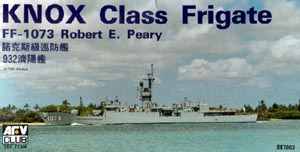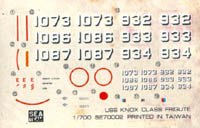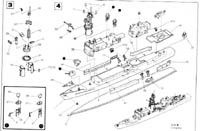 The
largest class of naval ships built in the western world since the end of the
Second World War are the 46 ships of Knox Class. The Knox class was designed
as a relatively cheap ASW ship, and as such they had just one propellor shaft
which produced a top speed of 27 knots. Built between 1969 and 1974, their
armament consisted of ASROC anti-submarine rockets, torpedoes and a 127mm
main gun. Later a Vulcan Phalanx CIWS and Harpoon missiles were added. A SH-2
Sea Sprite helicopter was also carried.
The
largest class of naval ships built in the western world since the end of the
Second World War are the 46 ships of Knox Class. The Knox class was designed
as a relatively cheap ASW ship, and as such they had just one propellor shaft
which produced a top speed of 27 knots. Built between 1969 and 1974, their
armament consisted of ASROC anti-submarine rockets, torpedoes and a 127mm
main gun. Later a Vulcan Phalanx CIWS and Harpoon missiles were added. A SH-2
Sea Sprite helicopter was also carried.
To the best of my knowledge, all of the ships have been either mothballed or sold in recent years. Some are operated by foreign navies, with the largest number being used by the Taiwanese Navy.
The Kit
 I
have long admired the looks of the Knox class (in fact I scratchbuilt a half
dozen or so in 1/2400 scale many years ago), and was pleasantly surprised
to see that one had been released in injected form by AFV Club. The kit consists
of one medium grey sprue containing 89 pieces. All parts are cleanly molded
with no evidence of flash apparent.
I
have long admired the looks of the Knox class (in fact I scratchbuilt a half
dozen or so in 1/2400 scale many years ago), and was pleasantly surprised
to see that one had been released in injected form by AFV Club. The kit consists
of one medium grey sprue containing 89 pieces. All parts are cleanly molded
with no evidence of flash apparent.
The hull is pretty bare, however there are facets to affix to
it which have various doors and other fixtures moulded to them. The bridge
has recessed windows as well as ASROC reloading doors in its forward face.
All structures which should be open - cranes, radars, lattice masts etc -
are moulded as solids and will best be replaced by either scratchbuilding
or aftermarket PE sets from one of the many companies that supply such items..The
ASROC, Phalanx CIWS and 127mm gun are all usuable as is, although some extra
detailing on the first two may also be possible. The ship's boats have slight
sink holes in them that will require filling.
Decals are provided for three USN ships (Robert E Peary FF 1073, Brewton FF 1086 & Kirk FF 1087), and three unnamed ROC ships. Warning circles are provided for the 127mm gun, ASROC and CIWS mount, as well as three Engineering Excellence awards and decals for the Seasprite helicopter. There are also three badges and a solid red circle that I know not what they are for. No landing deck markings are provided, although there are raised markings in place on the actual kit part. These may be either painted or sanded smooth and replaced with leftovers from the decal binder.
 The
instructions consist of a double-sided page
The
instructions consist of a double-sided page  showing
construction in four basic steps. Each step is illustrated in an exploded
diagram and there is also a drawing showing the completed model. A full colour
rear box cover is also provided as a marking guide.
showing
construction in four basic steps. Each step is illustrated in an exploded
diagram and there is also a drawing showing the completed model. A full colour
rear box cover is also provided as a marking guide.
Conclusion
With the addition of some PE rails and replacement of the solid lattice structures
this will be a very nice model to join my 1/700 escorts.
Copyright © SMML 2004